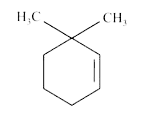1 - Bromo -2, 2 - dimethylcyclohexane on treatment with methanol gives



all of these
The correct Answer is:D
To solve the problem of what 1-bromo-2,2-dimethylcyclohexane gives upon treatment with methanol, we will follow these steps:
Step 1: Understand the structure of 1-bromo-2,2-dimethylcyclohexane
1-bromo-2,2-dimethylcyclohexane consists of a cyclohexane ring with a bromine atom (Br) at the 1-position and two methyl groups (CH3) at the 2-position. The structure can be represented as follows:
CH3|Br−−C−−CH3|CCCCC
Step 2: Reaction with methanol
When 1-bromo-2,2-dimethylcyclohexane is treated with methanol, which is a protic solvent, the bromine atom (a good leaving group) will leave first, forming a carbocation.
Step 3: Formation of carbocation
The leaving of bromine generates a carbocation at the 1-position of the cyclohexane. The structure of the carbocation can be depicted as:
CH3|C+|CCCCC
Step 4: Rearrangement of the carbocation
The carbocation can undergo rearrangement. A methyl group can shift from the 2-position to stabilize the carbocation, leading to a more stable tertiary carbocation.
Step 5: Elimination to form alkenes
After the formation of the carbocation, a proton (H+) can be eliminated from an adjacent carbon atom, resulting in the formation of a double bond (alkene).
Step 6: Possible products
From the rearranged carbocation, two possible alkenes can be formed depending on which hydrogen is eliminated:
1. If the proton is removed from the carbon adjacent to the carbocation, we can form one alkene.
2. If the proton is removed from the other adjacent carbon, we can form another alkene.
Conclusion
In total, multiple products can be formed from this reaction, including different isomers of alkenes. Therefore, the treatment of 1-bromo-2,2-dimethylcyclohexane with methanol can yield several products, including:
- 2,2-dimethylcyclohexene
- 1,2-dimethylcyclohexene
- Other possible isomers depending on the elimination of protons.
Final Answer
The treatment of 1-bromo-2,2-dimethylcyclohexane with methanol gives multiple alkene products.
---
1-bromo-2,2-dimethylcyclohexane consists of a cyclohexane ring with a bromine atom (Br) at the 1-position and two methyl groups (CH3) at the 2-position. The structure can be represented as follows:
When 1-bromo-2,2-dimethylcyclohexane is treated with methanol, which is a protic solvent, the bromine atom (a good leaving group) will leave first, forming a carbocation.
The leaving of bromine generates a carbocation at the 1-position of the cyclohexane. The structure of the carbocation can be depicted as:
The carbocation can undergo rearrangement. A methyl group can shift from the 2-position to stabilize the carbocation, leading to a more stable tertiary carbocation.
After the formation of the carbocation, a proton (H+) can be eliminated from an adjacent carbon atom, resulting in the formation of a double bond (alkene).
From the rearranged carbocation, two possible alkenes can be formed depending on which hydrogen is eliminated:
2. If the proton is removed from the other adjacent carbon, we can form another alkene.
In total, multiple products can be formed from this reaction, including different isomers of alkenes. Therefore, the treatment of 1-bromo-2,2-dimethylcyclohexane with methanol can yield several products, including:
- 1,2-dimethylcyclohexene
- Other possible isomers depending on the elimination of protons.
The treatment of 1-bromo-2,2-dimethylcyclohexane with methanol gives multiple alkene products.
Topper's Solved these Questions
Similar Questions
Knowledge Check
2-Phenyl-2-chloropropane on treatment with alc. KOH gives mainly
A2-PhenylpropeneB3-PhenylpropeneC1-Phenylpropan-2-olD1-Phenylpropan-3-ol2-Phenyl-2-chloropropane on treatment with alc. KOH gives mainly
A2-PhenylpropeneB3-PhenylpropeneC1-Phenylpropan-2-olD1-Phenylpropan-3-olAnisole on treatment with Br2/CS2 gives :
AbromobenzeneBmethyl-2-bromophenyl etherCo- and p- bromoanisoleDphenol
